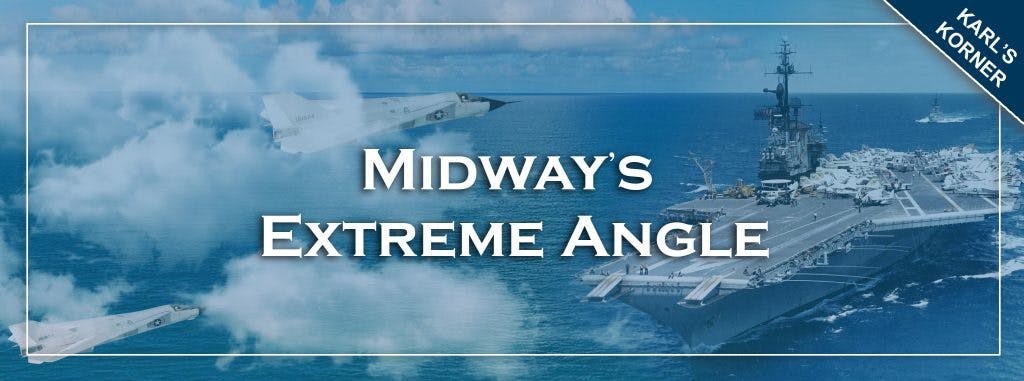 January 10, 2019 | Karl’s Korner
January 10, 2019 | Karl’s KornerMidway's Angled Deck
Hello and welcome back to “Karl’s Korner”, a historical segment written by myself, Karl Zingheim – Ship Historian of the USS Midway Museum! We are kicking off the new year with a new post about one of Midway's most prominent features... any guesses? That's right... Midway's angled deck! Do you know why Midway went through several deck modifications during her time of service? Let's dive in...
Midway's Extreme Angle
The USS Midway endured a 47-year career as a deploying carrier, a period that spanned breathtaking advances in naval aviation. Completed in 1945 at the height of the piston-engine era, the Midway’s flight deck ran the full length of the ship entirely down her centerline. This logical arrangement permitted the operation of masses of aircraft, but at the expense of allowing only launches or only recoveries at a time. This was particularly nettlesome in the landing recovery phase since landing cycles were kept tight between approaching aircraft, necessitating the spotting of recently-recovered aircraft forward in a dense parking “pack.” Though out of the way of the landing zone, the pack was still in the path of an oncoming aircraft, and if its tailhook missed the arresting wires, or the barriers failed to snag the spinning propeller, an aircraft could smash into parked planes with tragic consequences. The advent of jet aviation in the late 1940s stressed the straight deck concept to the breaking point since jets were even more energetic in their landings, being heavier and faster. There also tended to be a significant lag between throttle adjustments and the subsequent changes in engine thrust, making jet approaches more hazardous. Worse, with smooth, streamlined noses lacking whirling propeller blades, jets were not snagged as easily by the barriers, often giving pilots a choice of wafting over them or risking severe injury if the steel cable slid over the nose and sliced into the canopy!
Time For a Change...
To remain viable in the jet age, carrier aviation had to change its architecture, and British developments to solve this dilemma led to important breakthroughs in flight deck equipment, the most drastic being the very layout of the deck. Introducing an extension off the port side lengthened the landing area away from the often-crowded parking space forward, allowing aircraft that missed the arresting wires to continue flying for a climbing go-around. Gradually, straight deck carriers were altered with offset landing areas angled off the centerline. The Midway received such a change in her 1955 rebuild in Bremerton, Washington. While the angled deck helped solve some landing issues, aircraft design continued to evolve, and by the 1960s, an advanced, but heavy, aircraft emerged. The F-111 was an attempt to economize by having a high-performance warplane able to serve the differing needs of the Air Force and Navy with few modifications to the basic design. Unfortunately, the resulting airframe was very heavy (at 70,000 lbs) for a carrier aircraft, and it needed to operate at squadron strength. The Navy F-111B had a lengthier run-out before stopping on its arrested landings than other jets, which required a longer angled deck. Since the aircraft was intended to provide long-range fleet defense with AIM-54 Phoenix missiles, both the larger Forrestal-class supercarriers and the smaller Midway class needed to accommodate the type. For the Midway and her sisters, this meant another reconfiguration of the flight deck.
Midway Rebuilds Again
As development proceeded with the F-111B, the Midway entered the Hunter’s Point Naval Shipyard near San Francisco on 15 February 1966. Over the ensuing four years, the ship was extensively rebuilt with several modifications. The most drastic was an increase in flight deck area from 2.82 to 4.02 acres, marginally smaller than on a supercarrier. Part of this enlargement was claimed by an extended run-out area, pushing the angle deck edge from opposite the island superstructure to just short of the port catapult. This proximity to the catapult meant a drastic increase in the deck’s angle offset to 13-degrees from centerline. By comparison, the wider dimensions on supercarriers required only a 9-degree offset. An aircraft with a wide wingspan like the F-111B (70 feet) could now clear the port catapult and its jet blast deflector. While the Midway’s protracted rebuild went on, the F-111B, however, ran into trouble. Weight and overall size continued to plague the design, as well as disappointing engine performance. Combat experience over Vietnam showed that modern fighters still needed to dogfight other fighters, as well as loft long-range missiles, so the F-111B’s lack of agility proved its undoing. The Midway modification was more than halfway completed when the F-111B was cancelled in 1968. The demise of the F-111B ultimately led to the design of the lighter F-14 Tomcat, a type that was never assigned to the Midway, ironically, because it was also too large to operate in squadron strength on the older carrier. Due to the end of the F-111B, as well as major cost overruns on the Midway rebuild, similar plans for the Midway’s two sisters, Coral Sea and Franklin D. Roosevelt, were cancelled. In time, the large angle allowed the accommodation of the 80-foot span E-2 Hawkeye radar aircraft. To this day, the Midway can still lay claim to having the most drastic offset of any angled flight deck in the world! Thank you for reading, Midway Family! Please leave me a comment below and tell me what you thought of this month’s Karl’s Korner. Did you serve aboard the USS Midway or any aircraft carrier? If so, tell me which on in a comment below!
Launch em’… until next time,
Karl
Your Adventure Starts Now
Your email is the key to information that will open up all your possibilities for exploring the mighty Midway!

